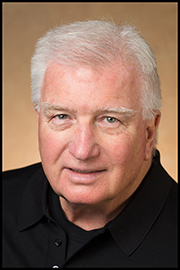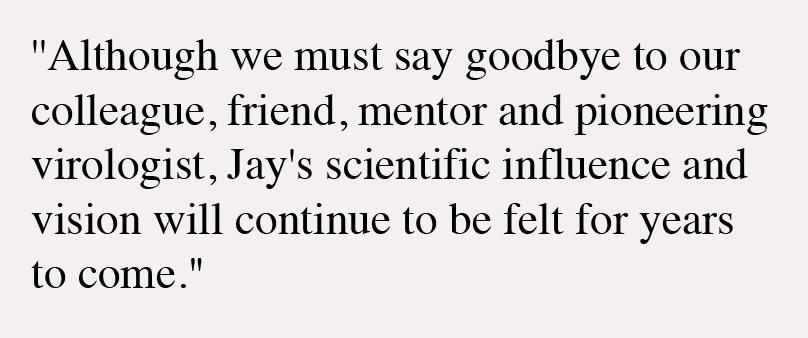Remembering Jay Nelson

OHSU and the world have lost a great scientist and leader. Jay A. Nelson, Ph.D., founding director of the Vaccine & Gene Therapy Institute, passed away after a long illness. A virologist with many scientific interests, Jay focused considerable attention on the herpes family of viruses, especially on cytomegalovirus, or CMV. He and his team carried out molecular analyses of human CMV replication and pathogenesis, determined molecular mechanisms of CMV latency, and were among the first to characterize microRNAs (miRNAs) produced during CMV infection. He was highly prolific, with many papers in the best journals, and he had an outstanding track record in obtaining grants for his lab and for large collaborative projects.
Jay came to OHSU from Scripps Research Institute in 1992, joining the Department of Microbiology and Immunology (now the Department of Molecular Microbiology and Immunology) in the School of Medicine.
Working with other research leaders at MMI, Jay helped to restructure the department and recruit many excellent faculty members. Under their leadership, over the subsequent 10 years, the department developed into one of the top microbiology departments in the country, if not the world.

From there Jay had a bigger vision: His goal was to assemble a group of highly collaborative virologists and immunologists to address the most pressing challenges in virology and infectious disease. The AIDS epidemic was in full swing in the 1990s, and the toll on the nation was mounting. He also saw that the use of nonhuman primates would be critical to his scientific vision. Thus, in 1998, he founded OHSU's Vaccine & Gene Therapy Institute at the West Campus, adjacent to the Oregon National Primate Research Center. Jay served as the founding director of VGTI until 2023. He and co-director Louis Picker forged VGTI into an international powerhouse in vaccine research, contributing to many profound discoveries in immunology.
Jay was not only a great scientist and a visionary leader, he was also a highly supportive mentor, a legacy that will have reverberations throughout the field for many years to come. He nurtured the careers of many successful scientists, some of whom remain at OHSU and others who have developed their careers elsewhere. He appreciated bringing together large multidisciplinary teams of scientists -- not just for the added analytical and intellectual power that a large group offered, but also because it gave him the opportunity to launch the careers of trainees.
About us
After primary infection with Human Cytomegalovirus (CMV), the virus goes dormant, or latent, in CD34+ hematopoietic progenitor cells (HPCs) in the bone marrow. Reactivation from latency is linked to differentiation down the myeloid lineage and results in the production of new infectious virus. A robust T cell response is able to control reactivating HCMV in immunocompetent individuals, but remains a significant cause of morbidity and mortality in solid organ and hematopoietic stem cell transplantation settings. Our lab aims to understand the molecular basis of the establishment, maintenance, and reactivation from latency. We study HCMV latency using a unique cell culture model system where we can infect CD34+ HPCs with HCMV and then maintain these cells in co-culture with stromal cells, which mimic the bone marrow environment, in order to establish latency. Following the latency culture period, we can then can stimulate these cells to reactivate. Using this cell culture model, we have identified multiple miRNAs that are encoded by HCMV as well as protein coding genes that are important in these processes, and we continue to explore how these viral gene products manipulate HPCs to achieve latency and/or reactivation. We are also involved in projects with other labs at VGTI that use CMV as a vaccine vector, and have contributed to studies of how miRNAs contribute to T cell responses during vaccination.